Leros: The Underrated Greek Island that Has It...
Discover Leros, a hidden Greek island...
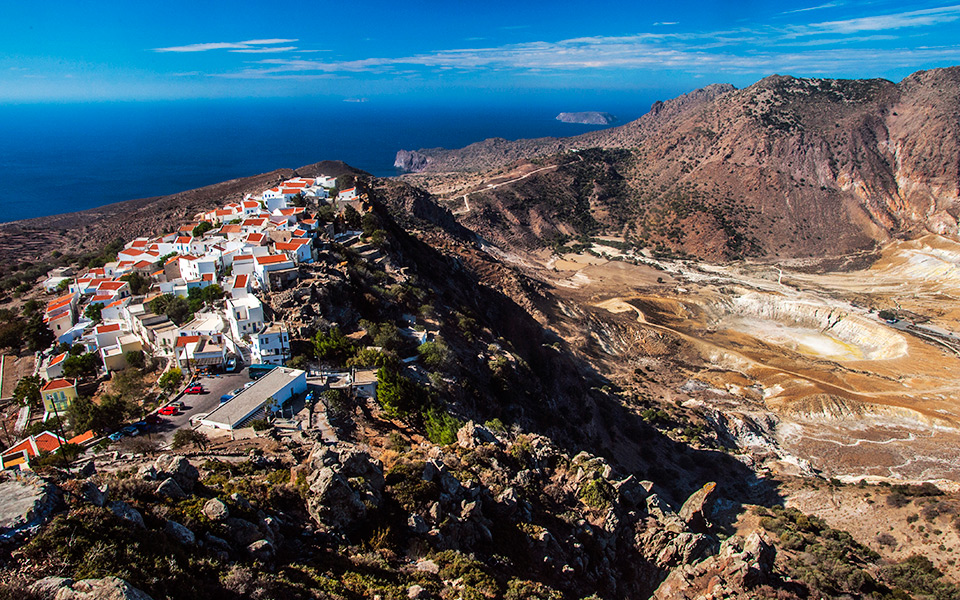
The village of Nikia is situated above the volcano's caldera in Nisyros.
© Clairy Moustafellou
More than just an island, Nisyros is also one of Greece’s few active volcanos. It began emerging from the sea about 150,000 years ago and has erupted numerous times over the millennia, with the last one occurring in 1887. Today one can visit the hydrothermal craters and walk inside one of the largest in the world, nicknamed “Stefanos”.
In the much photographed square of Porta in the village of Nikia, sit at one of the cafe tables that rim the round mosaic in the center of the square and order soumada or kanelada – sweet refreshing drinks made respectively with almonds and cinnamon.
Emporios, a village with homes densely clustered on the slopes underneath a medieval castle was deserted following an earthquake in 1933. Today its handful of cafes and tavernas are magnets for free-spirited travelers and artists.
Works created by the latter can be seen at Sterna Art Project – a wonderful minimalist space located inside the castle that hosts artists from all over the world.
In Emporios Melanopetra (Tel +30 697.806.0289, from 140 euros) is a renovated stone-built residence that has been converted into a guesthouse with two autonomous apartments.
In Mandraki stay at the hotel Romantzo, (Tel +30 22420.31340, from 35 euros) which has rooms with sea views.
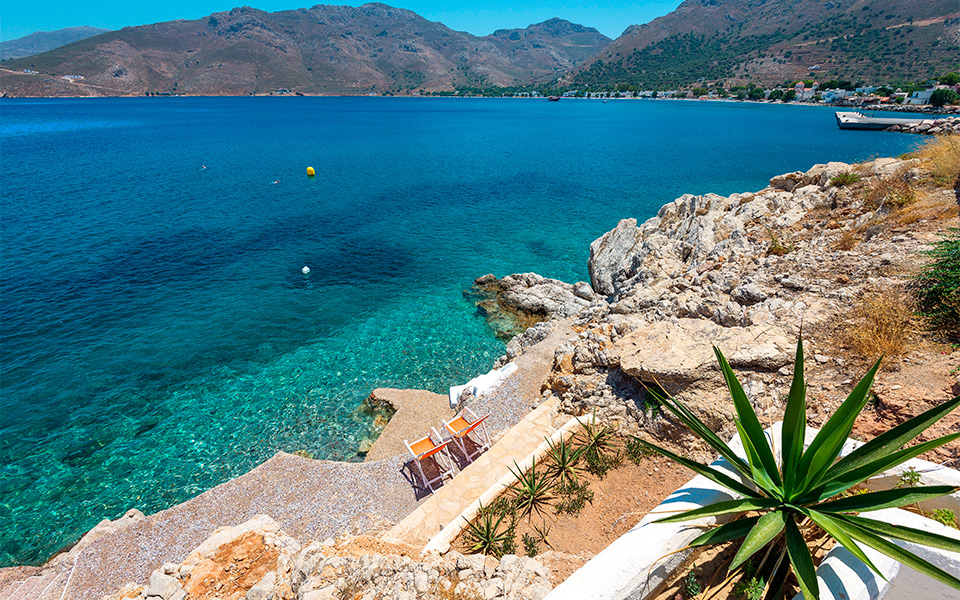
Tilos island
© Shutterstock
Thanks to its unique natural environment, the entire island of Tilos has been inducted into the Natura 2000 network of protected natural habitats. Further bolstering its green credentials, the island aims to become 100% dependent on renewable energy and is a candidate for the 2017 EU Sustainable Energy Awards.
In a cave in Tilos the remains of Europe’s last known population of dwarf elephants have been found: bones belonging to about 40 individuals that died a mere 4,000 years ago. Their thrilling story as well as other finds from the Neolithic Era are on display at the Dwarf Elephant Museum in Megalo Chorio.
The medieval village of Mikro Chorio with its stone-built homes and ancient walls was abandoned following the Second World War. In 1993, a group of friends decided to convert an old home that once belonged to one of their grandfathers into a bar. Now every summer music plays and drinks are served at outdoor tables as the ruins of the entire village are lit up and filled with life.
The island has a network of a total of 54km of signposted footpaths. Also ask the locals to direct you to the sea cave in the area of Loumboudi in Livadia which is accessible by boat or canoe. In the interior there is a small hidden beach with fine pebbles, where if you are lucky, you may even see seals.
Ilidi Rock in Livadia (Tel +30 22460.44293, from 60 euros) has studios, suites and apartments built into the rock.
Also in Livadia is the Hotel Eleni Beach (Tel +30 22460.44062 from 65 euros).
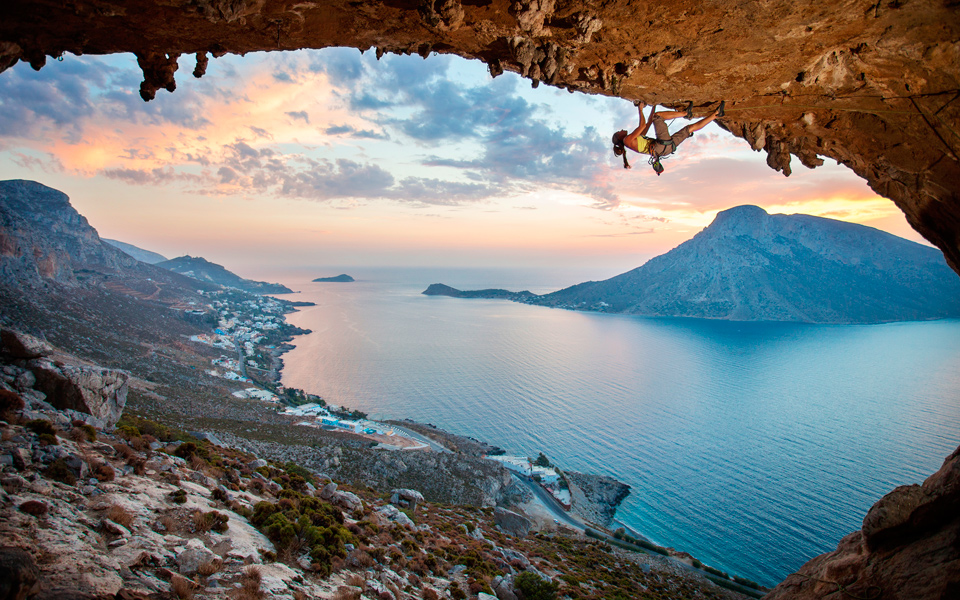
Climbing at Kalymnos with a view of the island of Telendos.
© Shutterstock
Kalymnos is known as one of the top rock-climbing destinations in the world. Almost 3,500 routes of every difficulty level have been opened across the island. Don’t miss visiting the village of Masouri with its fantastic views across the strait to the small, uninhabited island of Telendos (which also features plenty of climbing routes).
The waters in which Kalymnos’s famous sponge-divers once plied their trade today attract scuba divers who come for thrilling explorations of the area’s underwater caves, shipwrecks, sponge beds and WWII wreckage and artifacts.
In the traditional cafes in the main square of Pothia you will find unique local seafood meze dishes including spinialo (a speciality made with fouskes – an edible sea squirt – preserved in brine), octopus patties, sun-dried lobster tails and more). If all the adventure has left you more in the mood for meat, try the mouri – stuffed lamb cooked overnight in a covered clay pot. Sunday lunch on Kalymnos will be sure to include mirmizeli (a salad with barley rusks, shredded tomato, cucumber, capers and sharp, kopanisti cheese) and dolmades stuffed with rice and mincemeat.
Apollonia Hotel in Masouri is ideal for climbers due to its proximity to rock-climbing pistes (+30 22430.48094, from 55 euros) and has apartments with views of Telendos.
Another good option is Villa Melina (Tel +30 22430.22682, from 45 euros) in Pothia.
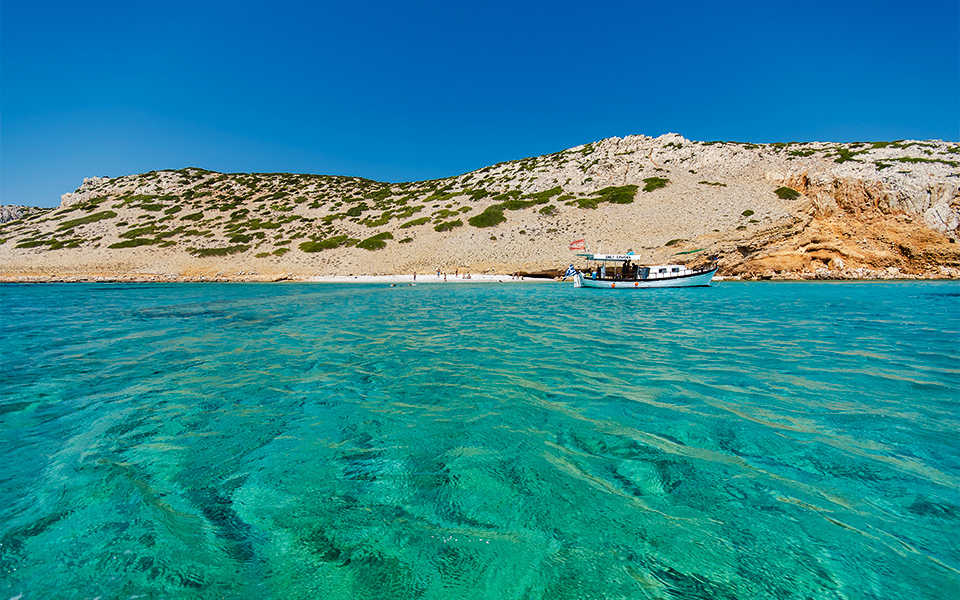
The uninhabited island of Koutsomytis at Astypalaia.
© Shutterstock
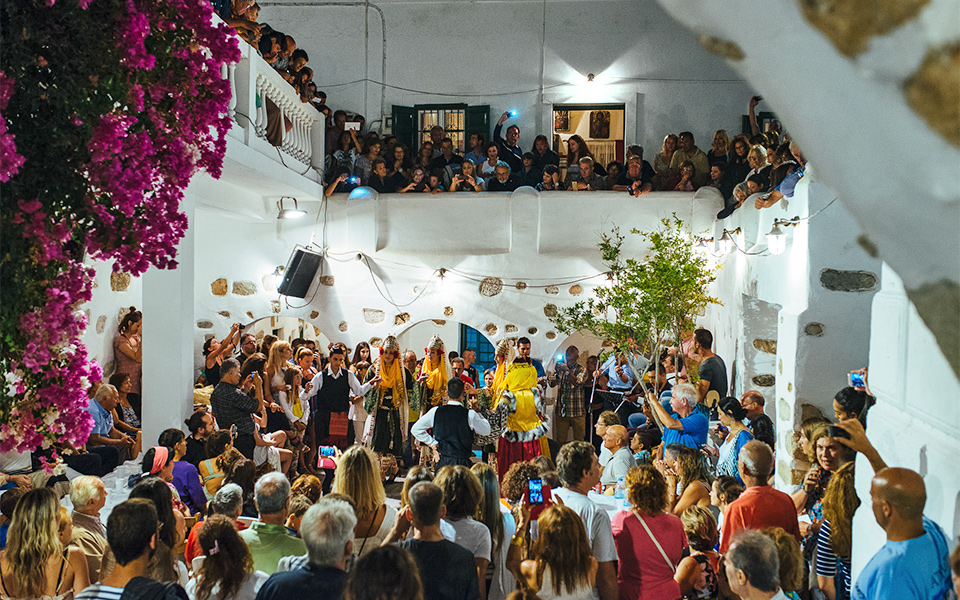
Traditional dancing takes place in the castle walls for the celebrations on the 15th of August.

The whitewashed village streets of Astypalaia.
© Shutterstock
Wherever you take your first swim, it will immediately make you forget (or perhaps even appreciate) the 10-hour boat ride from Piraeus. In Kaminakia you can combine swimming with a delicious lunch, whereas in Plakes you’ll bask in the sunshine on flat, smooth rocks. Among the highlights of any visit is a trip by boat to the islets of Koutsomitis and Kounoupes.
But the best beaches won’t just fall at your feet. The route to Vatses is 75% dirt road, but the reward is a large sandy stretch with incredible waters and a charming canteen that makes great cocktails. Aghios Ioannis o Richtis is another minor challenge to get to, requiring a 30 minute hike along a dirt trail, but has the best sunset on the island.
Unsuspecting visitors may be disappointed on seeing the streets of Chora almost empty at 9pm, but will quickly adapt to the Astypalean schedule: beach, taverna, a siesta at 19.00 before heading out at 23.30. Many, of course, will stay out all night at the landmark Mougou, a 100-year-old cafe that often plays host to famous impromptu parties, inspired by the unique ‘Astypalean energy’ that is said to spring from the castle that sits above the town like a crown.
Fish, honey and saffron form the trinity at the heart of the local cuisine. For seafood, a good choice is Maltezana, a small fishing village of 100 residents (150 in the summer) with small tavernas, whitewashed courtyards, colorful bougainvilleas and a quaint harbor where every morning the fishermen unload the catch that you will eat fried, grilled or stewed in kakavia.
In Chora try the filo pastry parcels (pougakia) drizzled in local honey and lambropita, a local pie flavored with saffron.
Saffron grows wild on the northern facing slopes of the island and is used in a variety of dishes, from risotto to fish. On the 15th of August it is traditional to eat the hearty ‘lambriano‘, lamb or goat stuffed with rice, liver and butter.
Astypalea also has 20 rock-climbing routes, explorable caves and well-marked hiking trails. Some routes also pass through local creameries where you can sample the local chlori cheese.
In Pera Gialo at the fully furnished an equipped homes run by Stampalia Studios (Tel +30 22430.61200, from 50 euros).
In Chora at Anatoli Studios (Tel +30 6973.546118, from 55 euros).

The beach at Emporeio in Kasos.
© Clairy Moustafellou
Kasos is an island with an energy that belies its small size, with exuberant local dishes and plenty of traditional music.
Sit at small taverna (or even better in the home of a local) and enjoy makarounes (homemade pasta with a soft local cheese) moschopougkia (sweets made with almonds), spinach pies and tiny dolmades.
Get to know the Kasiots, with their sense of humor and lyrical approach to life as expressed in the oft-repeated mantinades – short poems not unlike limericks. Music is a huge part of life here, largely focused on the Dodecanesian lyra and the lute.
With only 5 villages (the port of Fri, Aghia Marina, Arvanitohori, Poli and Panaghia), Kasos is an ideal destination for seasoned travelers, who having taken in many a spectacular destination are searching for destinations with their own distinct rhythms and personalities.
Evita Village (Tel +30 22450.41731, from 35 euros) has fully equipped apartments.
In Fri you will find the studios of Galanou View (Tel +30 22450.41235, from 30 euros).
Discover Leros, a hidden Greek island...
Patmos Aktis, Resort & Spa combines...
While some historic buildings teeter on...
Just an hour from Athens, Kea...